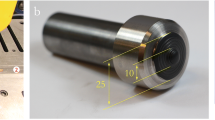Abstract
An investigation into the tensile strength and micro hardness of stainless steel 304 plates united by the heating radiation of microwaves has been studied in this paper. Three different sizes, 5 µm, 10 µm and 15 µm of nickel powder were used as an interfacing material. A domestic IFB microwave with 900 W output having a fixed frequency of 2.45 GHz was used during the experiment. The different sizes of nickel powder as slurry, variation in slurry by weight, and welding time were chosen as principal variables. Tensile strength and micro hardness were selected to study the mechanical strength of the joint. The centre composite design (CCD) was used as the design of experiments to optimize the results. The results showed that, as the welding time increases, tensile strength and hardness also increase, while tensile strength and micro hardness decrease as the particle size of nickel powder increases. There is a positive effect of slurry weight on the mechanical properties of the joint. From the result, the effect of welding time put up the most, followed by the particle size of powder and weight of slurry material. The optimum values as input variables of welding time, particle size, and slurry weight were found to be 13 min, 5 µm, and 3 g.









Similar content being viewed by others
References
M.S. Srinath, Apurbba Kumar Sharma, and Pradeep Kumar, Investigation on microstructural and mechanical properties of microwave processed dissimilar joints, Journal of Manufacturing Processes 13(2011), pg no.141–146
Osepchuk John M., A history of microwave heating applications, IEEE Trans Microwave Theory Tech., MIT (1984); 32(9):1200–24
Siores E, Rego D. Microwave applications in materials joining, J Mater Process Technology 1995; 48:619–25
Satnam Singh, Dheeraj Gupta and Vivek Jain, Recent applications of microwaves in materials joining and surface coatings, Journal of Engineering Manufacture, DOI: https://doi.org/10.1177/0954405414560778 –15 (2015) IMechE
D. Gupta, P.M. Bhovi, A.K. Sharma,and S. Dutta, Development and characterization of microwave composite cladding. J. Manuf. Process. (2015) 14, 243–249
Sharma AK, Srinath MS, and Pradeep K, Microwave joining of metallic materials. Indian Patent. (2009). Application no. 1994/Del/2009.
A Designer handbook series N 9014, Design guidelines for selection and use of stainless steel, distributed by Nickel Development Institute.
Shashi Prakash Dwivedi and Satpal Sharma, Effect of Process Parameters on Tensile Strength of 1018 Mild Steel Joints Fabricated by Microwave Welding, Metallogr. Microstruct. Anal. DOI https://doi.org/10.1007/s13632-013-0109-1 (2014) 3:58–69
Uma G, Vipin V, Overview of welding using microwave radiation, international conference on advanced production and industrial engineering, (2018) paper id ICAPIE-2018-PE MT 226.
Ms Uma Gautam & Vipin, Joining of Metal using Microwave Energy, International Conference on Emerging Trends in Electro-Mechanical Technologies and Management Advances in Electromechanical Technologies Lecture Notes in Mechanical Engineering (2019) https://doi.org/https://doi.org/10.1007/978-981-15-5463-6_92
Ms Uma Gautam et al, Microwave welding of Mild Steel in Advances in Electromechanical Technologies Lecture Notes in Mechanical Engineering (2019) https://doi.org/https://doi.org/10.1007/978-981-15-5463-6_79
Kanwarjeet S, Satpal S, Development and characterizations of co based microwave clad. ELK Asia Pacific J (2017) 978–93–85537–06–6.
Kanwarjeet S, Satpal S (2019) Fabrication and investigation of Co-based and CeO2-modified microwave coatings. Prot Met Phys Chem 55(2):352–358
Kanwarjeet S, Satpal S, Development of Ni-based and CeO2 modified coatings by microwave heating, materials and manufacturing processes (2016)
Yashwant Koli, N. Yuvaraj, S. Aravindan & Vipin, Multi-response Mathematical Modeling for Prediction of Weld Bead Geometry of AA6061-T6 Using Response Surface Methodology Transactions of the Indian Institute of Metals (2020) volume 73, pages 645–666
M. Pal, V. Kumar, S. Sehgal, H. Kumar, K. Saxena, A. Bagha, Microwave hybrid heating based optimized joining of SS304/ SS316, Materials and Manufacturing Processes, (2020) DOI: https://doi.org/10.1080/10426914.2020.1854469
Author information
Authors and Affiliations
Corresponding author
Additional information
Publisher's Note
Springer Nature remains neutral with regard to jurisdictional claims in published maps and institutional affiliations.
Rights and permissions
About this article
Cite this article
Gautam, U., Vipin Effect of Process Parameter on Tensile Strength and Hardness of SS304 Processed by Microwave Radiation. Trans Indian Inst Met 75, 653–662 (2022). https://doi.org/10.1007/s12666-021-02440-1
Received:
Accepted:
Published:
Issue Date:
DOI: https://doi.org/10.1007/s12666-021-02440-1




